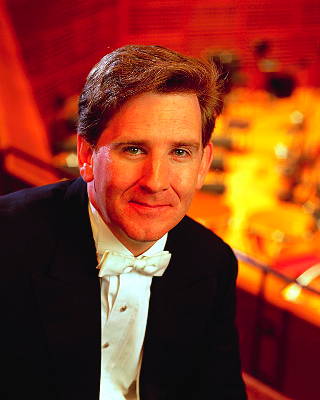|

Intense Leadership
Sierra, Ginastera and Rachmaninov
conducted by Alasdair Neale,
reviewed by LAWRENCE BUDMEN
During his long years of exile in America and Europe (following the Soviet revolution), Sergei Rachmaninoff was considered hopelessly retro; a 19th century romantic in the age of Stravinsky, Prokofiev and Shostakovich. Yet the music this Russian icon wrote in the West is far more adventurous than his earlier work. Dissonance, harmonic ambiguities and melodies of more astringent character are to be found in the four major works Rachmaninoff created during his exile -- the 3rd Symphony, Corelli Variations, 4th Piano Concerto and, his final masterpiece, Symphonic Dances. The ever present motif of the Dies irae haunts several of these scores.
Rachmaninoff's compositional career culminated in the 1940 Symphonic Dances, dedicated to conductor Eugene Ormandy and the Philadelphia Orchestra. (The composer considered the Ormandy-Philadelphia collaboration his most fervent and dedicated advocates.) This writer has heard many concert performances of this dark, brooding score. A scintillating version by Charles Dutoit and the Montreal Symphony and a luminous, glowing rendition by Mariss Jansons and the St Petersburg Philharmonic remain vivid memories.
On 27 September 2008 the young players of the New World Symphony, America's orchestral academy, tackled this angst-ridden masterpiece and proved second to none. The acoustics of the Lincoln Theater in Miami Beach, Florida, USA are often ungrateful for large scale orchestral works. Mahler and Strauss can sound harsh and shrill in this confined space. (The New World Symphony has recently broken ground on a new concert hall and 21st century arts complex, designed by renowned architect Frank Gehry.) On this evening, however, acoustical problems seemed to disappear as conductor Alasdair Neale led these gifted musicians in a riveting performance of Rachmaninoff's swan song.

Alasdair Neale. Photo © Terrence McCarthy
|
Neale vividly captured the sinewy foreboding of the score's opening pages. The contrasting theme was treated to gleaming romantic splendor; saxophone soloist and sensuous strings played with major league sheen and glamour. That evocative, dark tinged Tempo di valse of the second movement never sounded more romantically impassioned. A high octane, fierce reading of the final Lento assai -- Allegro vivace generated visceral excitement. Neale's ultra intense leadership and the ensemble's lush, wonderfully transparent instrumental textures produced a performance to remember.
Earlier in the evening, music with a classically Latin beat took center stage. Carnival for Orchestra by Roberto Sierra is the product of a commissioning project by California philanthropist Kathryn Gould. Nine composers have been selected to write scores for three orchestras in the suburban San Francisco Bay area -- the Santa Rosa Symphony, Marin Symphony and Oakland East Bay Symphony. (Alasdair Neale is music director of the Marin Symphony.) Each ensemble will perform all the commissioned works.
The Puerto Rican born Sierra, currently professor of composition at Cornell University, counts Gyorgy Ligeti among his teachers. A master of orchestration, Sierra has concocted a Technicolor score that takes its inspiration (in equal parts) from Carlos Chavez and John Williams. In the Sphinxes movement, Sierra charmingly quotes Schumann's keyboard showpiece Carnival. A Unicorns section explodes with lavish string and wind sonorities. The Dragon movement recalls Shostakovich at his wild, unhinged zenith. The Phoenix, a stunning finale, channels brilliant Latin rhythms and orchestral magic. This sure fire crowd pleaser is destined to become an orchestral standard. The dazzling playing of the New World musicians was a composer's dream. Sierra addressed the audience prior to the performance and acknowledged the rousing post performance response from upstate New York via the innovative Internet2 technology.
Alberto Ginastera's Variaciones Concertantes (1953) finds that seminal composer in a romantic mood. This orchestral showpiece affords an ensemble's first chair players rewarding solo opportunities in a series of variations on a languorous, dreamy principal theme. That melody was stated in richly burnished fashion by the ardent cello and gleaming harp. An elegant variation for flute and a somber one for richly fervent viola were striking. For sheer dexterity and stellar technique, the perpetual motion variation for solo violin was hard to surpass, articulated with super precision by the concertmaster. The concluding Rondo burst forth with a feast of pastoral color under Neale's orchestral wizardry. This remarkable young ensemble has begun the season with a stunning display of instrumental firepower.
Copyright © 18 October 2008
Lawrence Budmen, Miami Beach, USA

Michael Tilson Thomas conducts the New World Symphony in Ravel's Rhapsodie Espagnole, Stravinsky's Firebird Suite and Capriccio for Piano and Orchestra and Ravel's Concerto for the Left Hand with Yuja Wang as soloist on 18 and 19 October 2008 at the Lincoln Theater, Miami Beach, Florida, USA. On 25 October Tilson Thomas leads Strauss' Also Sprach Zarathustra and Beethoven's Eroica Symphony at the Adrienne Arsht Center's Knight Concert Hall in Miami. New York Philharmonic principal cellist Carter Brey joins NWS members for Schubert's Cello Quintet on 2 November at the Lincoln. The program also features chamber scores by Schumann and Bartók. On 8 and 9 November 2008 Alasdair Neale conducts Kevin Puts' Hymn to Sun, Copland's 3rd Symphony and Korngold's Violin Concerto with Vadim Gluzman as soloist. Visit www.nws.edu for more information. |
IMPRESSIONS OF ITALY - ALASDAIR NEALE AND THE NWS
|

